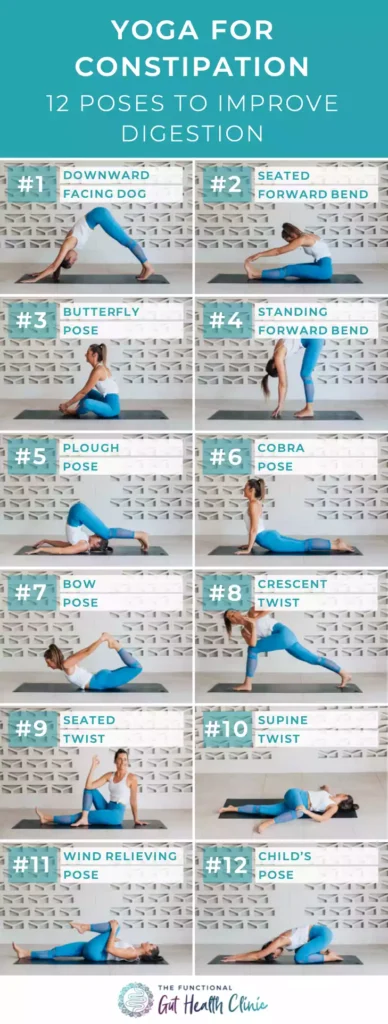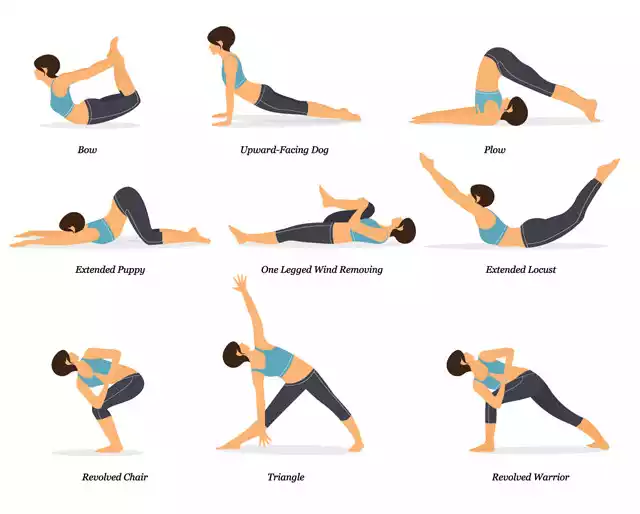Constipation is a common issue that affects millions of people worldwide. While there are various remedies available, yoga has emerged as a natural and effective solution for alleviating constipation. The practice of yoga not only helps in improving digestion but also promotes overall well-being. Historically, yoga has been practiced for thousands of years, with its roots tracing back to ancient India. The ancient yogis believed that a healthy digestive system is the cornerstone of good health. They developed specific poses and breathing techniques to stimulate the digestive organs and promote regular bowel movements.
Table of Contents
ToggleBenefits of Yoga for Digestive Health
Yoga offers numerous benefits for digestive health. The gentle stretching and twisting movements of yoga poses help in massaging the internal organs, which in turn stimulates the digestive system. This can lead to improved digestion and regular bowel movements. Additionally, yoga helps in reducing stress, which is a common cause of digestive issues. When the body is relaxed, the digestive system functions more efficiently.
Key Benefits:
• Improved Digestion: Yoga poses like the Seated Forward Bend and Supine Twist massage the abdominal organs, promoting better digestion.
• Stress Reduction: Practices like deep breathing and meditation help in reducing stress, which can improve digestive health.
• Enhanced Blood Flow: Yoga increases blood flow to the digestive organs, aiding in their proper functioning.
• Detoxification: Certain yoga poses help in detoxifying the body by stimulating the liver and kidneys.
How Yoga Helps Alleviate Constipation
Yoga helps in alleviating constipation through a combination of physical movements, breathing exercises, and relaxation techniques. The physical movements involved in yoga poses help in stimulating the digestive organs, which can lead to improved bowel movements. Breathing exercises, on the other hand, help in reducing stress and promoting relaxation, which can also aid in relieving constipation.
Mechanisms of Relief:
• Stimulating the Digestive Organs: Poses like the Wind-Relieving Pose and Child’s Pose apply gentle pressure on the abdomen, stimulating the digestive organs.
• Promoting Relaxation: Deep breathing exercises and meditation help in reducing stress, which can improve digestive health.
• Improving Blood Circulation: Yoga increases blood flow to the digestive organs, aiding in their proper functioning.
• Enhancing Muscle Tone: Yoga strengthens the muscles of the abdomen, which can help in promoting regular bowel movements.
Top Yoga Poses for Constipation

Certain yoga poses are particularly effective in relieving constipation. These poses focus on stimulating the digestive organs, promoting relaxation, and improving blood circulation. Here are some of the top yoga poses for constipation:
Wind-Relieving Pose (Pawanmuktasana)
This pose is specifically designed to relieve gas and improve digestion. It involves lying on your back and bringing your knees to your chest, which applies gentle pressure on the abdomen.
Child’s Pose (Balasana)
This pose helps in relieving stress and promoting relaxation. It involves sitting on your heels and bending forward, with your arms extended in front of you.
Seated Forward Bend (Paschimottanasana)
This pose helps in massaging the abdominal organs and improving digestion. It involves sitting with your legs extended in front of you and bending forward to touch your toes.
Cat-Cow Pose (Marjaryasana-Bitilasana)
This pose helps in enhancing spinal flexibility and improving blood circulation. It involves moving between a rounded back (Cat Pose) and an arched back (Cow Pose).
Supine Twist (Supta Matsyendrasana)
This pose helps in improving digestion and detoxification. It involves lying on your back and twisting your lower body to one side while keeping your upper body straight.
Detailed Guide to Each Pose

Step-by-Step Instructions
Wind-Relieving Pose (Pawanmuktasana)
1. Lie on your back with your legs extended and arms at your sides.
2. Inhale deeply and bring your right knee towards your chest.
3. Hold your knee with both hands and apply gentle pressure on your abdomen.
4. Hold the pose for 20-30 seconds while breathing deeply.
5. Release and repeat with the left knee.
Child’s Pose (Balasana)
1. Kneel on the floor with your big toes touching and knees spread apart.
2. Sit back on your heels and extend your arms in front of you.
3. Lower your torso between your thighs and rest your forehead on the floor.
4. Hold the pose for 1-2 minutes while breathing deeply.
Seated Forward Bend (Paschimottanasana)
1. Sit on the floor with your legs extended in front of you.
2. Inhale deeply and raise your arms overhead.
3. Exhale and bend forward from your hips, reaching for your toes.
4. Hold the pose for 1-2 minutes while breathing deeply.
Cat-Cow Pose (Marjaryasana-Bitilasana)
1. Start on your hands and knees with your wrists directly under your shoulders and knees under your hips.
2. Inhale and arch your back (Cow Pose), lifting your head and tailbone towards the ceiling.
3. Exhale and round your back (Cat Pose), tucking your chin to your chest.
4. Repeat the sequence for 1-2 minutes while breathing deeply.
Supine Twist (Supta Matsyendrasana)
1. Lie on your back with your legs extended and arms at your sides.
2. Bend your right knee and place your foot on the floor.
3. Use your left hand to guide your right knee across your body to the left side.
4. Extend your right arm out to the side and turn your head to the right.
5. Hold the pose for 1-2 minutes while breathing deeply.
6. Release and repeat on the other side.
Tips for Beginners
Starting a yoga practice can be intimidating, but with the right approach, it can be a rewarding experience. Here are some tips for beginners:
Start Slow
– Begin with simple poses and gradually progress to more advanced ones.
– Focus on your breath and move mindfully through each pose.
Listen to Your Body
– Pay attention to how your body feels and avoid pushing yourself too hard.
– If a pose feels uncomfortable or painful, modify it or skip it altogether.
Practice Regularly
– Consistency is key to reaping the benefits of yoga. Aim to practice at least 3-4 times a week.
– Even a short practice of 10-15 minutes can be beneficial.
Seek Guidance
– Consider taking a beginner’s yoga class or following online tutorials to learn proper alignment and technique.
– Don’t hesitate to ask for help or clarification if you’re unsure about a pose.
Incorporating Yoga into Your Daily Routine
Incorporating yoga into your daily routine can have a profound impact on your digestive health and overall well-being. Here are some tips to help you create a consistent yoga practice:
Creating a Consistent Practice
Set a Schedule
– Choose a specific time each day to practice yoga, whether it’s in the morning, afternoon, or evening.
– Stick to your schedule as much as possible to establish a routine.
Create a Dedicated Space
– Designate a quiet and comfortable space in your home for your yoga practice.
– Keep your yoga mat, props, and any other essentials in this space.
Start Small
– Begin with short sessions of 10-15 minutes and gradually increase the duration as you become more comfortable.
– Focus on quality over quantity, ensuring that you perform each pose mindfully and with proper alignment.
Stay Motivated
– Set realistic goals and track your progress to stay motivated.
– Join a yoga community or find a yoga buddy to practice with for added support and accountability.
Combining Yoga with Other Healthy Habits
Balanced Diet
– Eat a balanced diet rich in fiber, fruits, vegetables, and whole grains to support digestive health.
– Stay hydrated by drinking plenty of water throughout the day.
Regular Exercise
– Complement your yoga practice with other forms of exercise, such as walking, swimming, or cycling.
– Aim for at least 30 minutes of moderate exercise most days of the week.
Stress Management
– Practice stress-reducing techniques such as meditation, deep breathing, or mindfulness.
– Prioritize self-care and make time for activities that bring you joy and relaxation.
Adequate Sleep
– Ensure you get enough sleep each night to support overall health and well-being.
– Establish a regular sleep routine and create a relaxing bedtime environment.
Common Mistakes to Avoid
While practicing yoga for constipation relief, it’s important to avoid common mistakes that can hinder your progress or lead to injury. Here are some mistakes to watch out for:
Overstretching and Injury Prevention
Listen to Your Body
– Pay attention to your body’s signals and avoid pushing yourself too hard.
– If a pose feels uncomfortable or painful, modify it or skip it altogether.
Warm Up Properly
– Always start your practice with a gentle warm-up to prepare your muscles and joints for the poses.
– Incorporate dynamic stretches and movements to increase blood flow and flexibility.
Use Props
– Use yoga props such as blocks, straps, and bolsters to support your practice and prevent overstretching.
– Props can help you achieve proper alignment and make poses more accessible.
Practice Mindfully
– Move slowly and mindfully through each pose, focusing on your breath and alignment.
– Avoid rushing through your practice or forcing yourself into poses.
Misalignment and Proper Form
Learn Proper Alignment
– Take the time to learn the correct alignment for each pose to prevent injury and maximize benefits.
– Consider taking a beginner’s yoga class or following online tutorials for guidance.
Use a Mirror
– Practice in front of a mirror to check your alignment and make adjustments as needed.
– Pay attention to your posture and ensure that your body is properly aligned in each pose.
Seek Feedback
– Ask a yoga instructor or experienced practitioner for feedback on your form and alignment.
– Don’t hesitate to ask for help or clarification if you’re unsure about a pose.
Be Patient
– Remember that yoga is a journey, and progress takes time.
– Be patient with yourself and celebrate small achievements along the way.
Additional Tips for Managing Constipation
In addition to practicing yoga, there are several other strategies you can use to manage constipation and improve your digestive health. Here are some additional tips:
Dietary Recommendations
Increase Fiber Intake
– Eat a diet rich in fiber, including fruits, vegetables, whole grains, and legumes.
– Fiber helps to bulk up stool and promote regular bowel movements.
Stay Hydrated
– Drink plenty of water throughout the day to keep your digestive system hydrated.
– Aim for at least 8 glasses of water daily, or more if you’re physically active.
Limit Processed Foods
– Avoid processed foods, which can be low in fiber and high in unhealthy fats and sugars.
– Opt for whole, unprocessed foods whenever possible.
Eat Regular Meals
– Establish regular meal times and avoid skipping meals.
– Eating at consistent times can help regulate your digestive system.
Lifestyle Changes
Regular Exercise
– Engage in regular physical activity to stimulate your digestive system and promote regular bowel movements.
– Aim for at least 30 minutes of moderate exercise most days of the week.
Stress Management
– Practice stress-reducing techniques such as meditation, deep breathing, or mindfulness.
– Prioritize self-care and make time for activities that bring you joy and relaxation.
Adequate Sleep
– Ensure you get enough sleep each night to support overall health and well-being.
– Establish a regular sleep routine and create a relaxing bedtime environment.
Healthy Habits
– Avoid smoking and limit alcohol consumption, as these can negatively impact digestive health.
– Maintain a healthy weight to reduce the risk of digestive issues.
Relevant Data Table For Which Yoga is Best for Constipation:
| Yoga Pose | Benefits for Constipation | Difficulty Level | Duration (Minutes) |
| Wind-Relieving Pose (Pawanmuktasana) | Stimulates bowel movements | Easy | 3-5 |
| Child’s Pose (Balasana) | Relieves stress and promotes relaxation | Easy | 5-10 |
| Seated Forward Bend (Paschimottanasana) | Massages abdominal organs | Moderate | 5-7 |
| Cat-Cow Pose (Marjaryasana-Bitilasana) | Enhances spinal flexibility | Easy | 5-7 |
| Supine Twist (Supta Matsyendrasana) | Improves digestion and detoxification | Moderate | 3-5 |
FAQs:
1. How often should I practice yoga to relieve constipation?
Practicing yoga regularly can significantly improve digestive health and alleviate constipation. Aim to practice yoga at least 3-4 times a week for optimal results. Consistency is key, so try to establish a routine that fits your schedule. Even short sessions of 10-15 minutes can be beneficial if practiced regularly. Incorporate a variety of poses that target the digestive system, such as the Wind-Relieving Pose, Child’s Pose, and Seated Forward Bend. Additionally, focus on deep breathing exercises and relaxation techniques to reduce stress, which can also contribute to better digestive health.
2. Are there any poses I should avoid if I have severe constipation?
While yoga can be beneficial for relieving constipation, certain poses may not be suitable for individuals with severe constipation or other digestive issues. Avoid poses that put excessive pressure on the abdomen or involve intense twisting movements, as these can exacerbate discomfort. Instead, focus on gentle poses that promote relaxation and stimulate the digestive organs. Poses like the Child’s Pose, Cat-Cow Pose, and Supine Twist are generally safe and effective for individuals with severe constipation. Always listen to your body and modify poses as needed to avoid discomfort or pain.
3. Can yoga replace medication for constipation?
Yoga can be a valuable complementary therapy for managing constipation, but it should not replace medication prescribed by a healthcare professional. While yoga can help improve digestion, reduce stress, and promote regular bowel movements, it may not be sufficient for individuals with chronic or severe constipation. If you are experiencing persistent constipation, it’s important to consult with a healthcare provider to determine the underlying cause and receive appropriate treatment. Yoga can be used alongside medication and other treatments to enhance overall digestive health and well-being.
4. How long does it take to see results from yoga for constipation?
The time it takes to see results from practicing yoga for constipation can vary depending on individual factors such as the severity of constipation, consistency of practice, and overall lifestyle. Some individuals may experience relief within a few days of regular practice, while others may take several weeks to notice significant improvements. Consistency is key, so aim to practice yoga regularly and incorporate other healthy habits such as a balanced diet, adequate hydration, and regular exercise. Be patient and give your body time to respond to the practice.
5. Is it safe to practice yoga for constipation during pregnancy?
Yoga can be a safe and effective way to manage constipation during pregnancy, but it’s important to choose poses that are appropriate for your stage of pregnancy and avoid poses that put excessive pressure on the abdomen. Gentle poses such as the Child’s Pose, Cat-Cow Pose, and Seated Forward Bend can help relieve constipation and promote relaxation. Always consult with your healthcare provider before starting a yoga practice during pregnancy, and consider taking a prenatal yoga class to learn poses that are safe and beneficial for both you and your baby.
Conclusion:
Incorporating specific yoga poses into your daily routine can significantly alleviate constipation and improve overall digestive health. By understanding the benefits, practicing the recommended poses, and avoiding common mistakes, you can achieve better digestive wellness. Remember to combine yoga with a balanced diet and healthy lifestyle for optimal results. For more information on yoga poses for constipation, you can visit Yoga Journal and Medical News Today.
Posts References:
Yoga for Constipation: 7 Poses For When You’re Blocked Up
Yoga for constipation: 8 poses for quick relief – MedicalNewsToday






